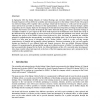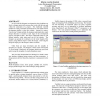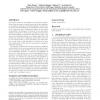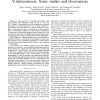1000 search results - page 50 / 200 » Designing for experiences: randomness as a resource |
ELPUB
2007
ACM
13 years 11 months ago
2007
ACM
In September 2004 the Italian Ministry of Cultural Heritage and Activities (MiBAC) committed to Scuola Normale Superiore di Pisa (SNS) the scientific and technical project for the...
ICCV
2011
IEEE
12 years 7 months ago
2011
IEEE
Many state-of-the-art segmentation algorithms rely on Markov or Conditional Random Field models designed to enforce spatial and global consistency constraints. This is often accom...
ACMDIS
2000
ACM
14 years 6 hour ago
2000
ACM
In real world development environments where deadlines are fixed, a designer must craft a process that works with the team and within the constraints of a project. The traditional...
EMSOFT
2009
Springer
14 years 2 months ago
2009
Springer
The major obstacle to use multicores for real-time applications is that we may not predict and provide any guarantee on real-time properties of embedded software on such platforms...
ISVLSI
2007
IEEE
14 years 1 months ago
2007
IEEE
— Y -interconnects for VLSI chips are based on the use of global and semi-global wiring in only 0◦ , 60◦ , and 120◦ . Though X-interconnects are fast replacing the traditio...




